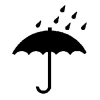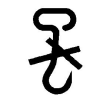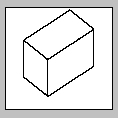| Chair cane (Rattan) | [German version] |
Table of contents |
|
| General: | ||
| Product information | ||
| Packaging | ||
| Transport | ||
| Container transport | ||
| Cargo securing | ||
Product information
Product name
| German | Stuhlrohr, Rattan |
| English | Rattan, chair cane |
| French | Rotin |
| Spanish | Rattan, chair cane |
| Scientific | Calamus rotang |
| CN/HS number * | 1401 01 20 |
(* EU Combined Nomenclature/Harmonized System)
Product description
Chair cane belongs to the category fibers/fibrous materials, which are classified as follows [24]:
Plant hairs:
| Cotton seed-hairs | |
| Kapok tree fruit hairs |
Stalk fibers from dicotyledonous plants (soft fibers):
| Flax, ramie (fine spinnable fibers) | |
| Hemp, jute, kenaf (coarse spinnable fibers) |
Leaf fibers (hard fibers):
| Sisal, Manila hemp, palm fibers (poor spinning characteristics) |
Bast:
| Linden, raffia palm, willow |
Basketwork material:
| Coconut fiber, chair cane, halfa, piassava, esparto |
Chair cane consists of the 0.5 – 4.5 cm thick shoots of the rattan palm (Calamus rotang), a member of the palm family (Palmae), and is also known as Spanish cane or rattan cane.
It comes from climbing palms in particular from Indonesia, which climb up to the crowns of the highest jungle trees and form dense thickets. The up to 4.5 cm thick, generally 50 m long pliable climbing stems are cut off approx. 1 m above the ground and pulled down out of the trees. They are then cut into pieces, and thorns and leaves are removed.
As the long shoot is pulled in, it is wound up gradually, for which purpose the thorny leaves and any thorns on the shoot itself have to be carefully removed. Since Calamus species form very dense thickets, harvesting them is particularly difficult.
Rattan is exported in various forms: whole, peeled and matted, decored and sometimes as broken chair cane. It is also supplied in washed or unwashed form.
The following are the main varieties:
| „Borneo“ varieties | |
| „Celebes“ varieties | |
| „Malaysia“ varieties | |
| „Sumatra“ varieties |
Quality / Duration of storage
Whole chair cane should be a natural yellow color, bleached, washed and free of nodes. Peeled chair cane is classified according to color and size: 1st grade cane is evenly straw-colored and flexible throughout; 2nd and 3rd grade cane is of a less pronounced color and is less flexible. Decored chair cane is assessed by color, cleanness, uniformity and flexibility. The highest quality is known as „extra selected“, the lowest as „common. Low quality canes are uneven in color.
Moisture-damaged goods must be rejected prior to loading, as the resultant discoloration and blotchiness may cause considerable depreciation. In the case of relatively long exposure to moisture, the cane may become moldy and rotten.
Subject to compliance with the appropriate humidity/moisture conditions, duration of storage is not a limiting factor as regards transport and storage life.
Intended use
After processing, the material is used in the basketware and wicker furniture industry and the craft industry as well as in the production of walking sticks, carpet beaters etc.. More recently, it has been shipped increasingly in the form of semifinished products, the outer layer being processed into weaving cane, binding cane and rattan split and the core being processed into wicker and round, flat, flat-oval and wedge-shaped weaving strips.
Figure
(Click on the individual Figures to enlarge them.)
 Figure 1 |
Countries of origin
This Table shows only a selection of the most important countries of origin and should not be thought of as exhaustive.
| Europe | |
| Africa | |
| Asia | Indonesia, (islands of Borneo, Celebes and Sumatra), Malaysia, Singapore, Indo-China, New Guinea |
| America | |
| Australia |
Back to beginning
Packaging
„Borneo“ and „Sumatra“ varieties: in approx. 50 kg bundles, bundled in U shape, length of bundles approx. 3 – 3.5 m.
„Celebes“ varieties: in straight approx. 50 kg bunches, length of bunches approx. 3 – 4 m.
„Malaysia“ varieties: straight bunches of 25 – 80 items.
Bundles and bunches are held together unpackaged with cane.
| Marking of packages | ||
 Keep dry |
 Use no hooks |
 Keep away from heat (solar radiation) |
Back to beginning
Transport
Symbols
 General cargo |
Means of transport
Ship, truck, railroad
Container transport
Standard containers , subject to compliance with water content of goods, packaging and flooring.
Cargo handling
In damp weather (rain, snow), the cargo must be protected from moisture, since chair cane is strongly hygroscopic and readily absorbs moisture. Moisture damage leads to discoloration, staining, mold and rot. Hooks must not be used for cargo handling.
Stowage factor
| 4.53 m3/t (bundles, Singapore) [1] |
Stowage space requirements
Cool, dry
Decored chair cane in particular requires cool holds. Its susceptibility to staining means that chair cane requires particularly dry, clean holds/containers.
Segregation
Fiber rope, thin fiber nets
Due to the simple types of marking used (cane strips are either marked with different colors or small letters), chair cane should where possible not be stowed in a hold together with other batches of chair cane destined for different ports.
Cargo securing
The cargo is to be secured in such a way that the bundles/bunches are not damaged. The ends of chair cane are seldom protected against bumping and dragging.
Back to beginning
Risk factors and loss prevention
RF Temperature
Chair cane requires particular temperature, humidity/moisture and possibly ventilation conditions (SC VI) (storage climate conditions).
Favorable travel temperature range: no lower limit – 25°C
Decored chair cane in particular is highly susceptible to drying-out, which makes it brittle and useless for its intended purpose. Therefore store it under cool conditions and maintain water content.
Back to beginning
RF Humidity/Moisture
Chair cane requires particular temperature, humidity/moisture and possibly ventilation conditions (SC VI) (storage climate conditions).
| Designation | Humidity/water content | Source |
| Relative humidity | 70% | [1] |
| Water content | 10 – 12% | [1] |
| Maximum equilibrium moisture content | 65% | [1] |
Chair cane behaves strongly hygroscopically (hygroscopicity). It absorbs large quantities of water vapor, but also releases it, causing it to dry out and become brittle and thus useless for the production of basketware. It must therefore be protected from sea, rain and condensation water and also from high levels of relative humidity, as there is otherwise a risk of depreciation caused by discoloration, staining and, especially with decored chair cane, mold and decay due to structural breakdown.
In the case of severe exposure to moisture, decored chair cane in particular may succumb to mold and structural breakdown (decay).
Decored chair cane dries out easily, becoming brittle and thus unusable.
Unwashed chair cane is less sensitive to contact with fresh and salt water than washed cane.
Back to beginning
RF Ventilation
Chair cane requires particular temperature, humidity/moisture and possibly ventilation conditions (SC VI) (storage climate conditions).
If the product is loaded for shipment in a dry state, it does not have any particular ventilation requirements.
Problems arise if the product, packaging and/or ceiling/flooring are too damp. In this case, the following ventilation measures should be implemented:
air exchange rate: 10 changes/hour (airing)
Due to the activity of microorganisms, an O2 shortage or increased CO2 concentration may occur. Therefore, before anybody enters the hold, it must be ventilated and a gas measurement carried out where necessary.
Back to beginning
RF Biotic activity
Chair cane displays 3rd order biotic activity.
It belongs to the class of goods in which respiration processes are suspended, but in which biochemical, microbial and other decomposition processes still proceed.
Back to beginning
RF Gases
Due to the activity of microorganisms, an O2 shortage or increased CO2 concentration may occur. Therefore, before anybody enters the hold, it must be ventilated and a gas measurement carried out where necessary. The TLV of the hold air is 0.49 vol.%.
Back to beginning
RF Self-heating / Spontaneous combustion
The characteristics of the raw material may cause it to behave like a substance from Class 4.1 (Flammable solids) of the IMDG Code/ADR.
Back to beginning
RF Odor
| Active behavior | Chair cane is neutral in odor. |
| Passive behavior | Chair cane is sensitive to unpleasant or pungent odors. |
Back to beginning
RF Contamination
| Active behavior | Chair cane does not cause contamination. |
| Passive behavior | Chair cane is extremely sensitive to contamination. Holds or containers must therefore be suitably clean and in a thoroughly hygienic condition, as there is in particular a risk of staining. Contamination, primarily on contact with fats/oils, reduces the value of the unpackaged goods, in particular washed chair cane. Matters may be improved by retreating the cane (washing with running fresh water and scouring with clean sand and subsequent drying). However, the center of the core may rot and fat/oil cannot be removed by the washing process, since it will have impregnated the outer bark. |
Back to beginning
RF Mechanical influences
Due to its sensitivity to pressure, other goods must not be stowed on top of chair cane.
Back to beginning
RF Toxicity / Hazards to health
Due to the activity of microorganisms, a life-threatening shortage of oxygen may arise in the hold or container. Thus, before anybody enters the hold, it must be ventilated and, if necessary, a gas measurement carried out. The TLV for CO2 concentration is 0.49 vol.%.
Back to beginning
RF Shrinkage/Shortage
Drying-out may cause weight loss. Decored chair cane is particularly susceptible to this risk.
Unclearly marked bundles/bunches may result in losses of volume due to incorrect delivery.
Back to beginning
RF Insect infestation / Diseases
Chair cane may lose value due to the activity of microorganisms.
Back to beginning
